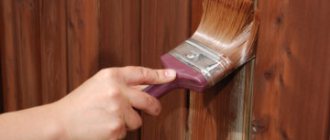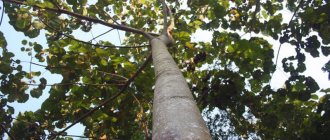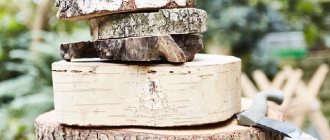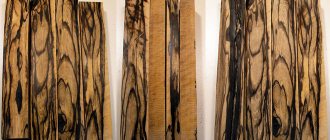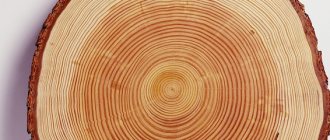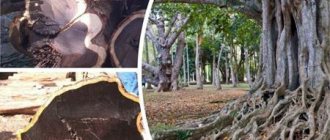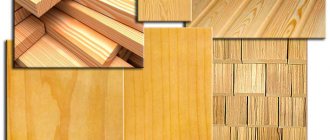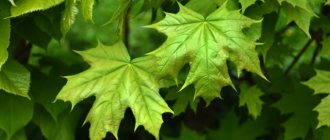Botanical description
Larches are large, straight-trunked trees . Adult specimens in the wild reach a height of up to 30–40 m, rarely lower than 23 m. The diameter of the lower part of the trunk reaches 1.5 m. The root system is taprooted, the depth of penetration depends on the soil. In permafrost conditions it is superficial, with a large number of adventitious roots. The bark is brown or dark gray in color, thickens with age and becomes fissured.
The crowns are sparse, young trees have a regular cone shape . In adulthood they become wide and ovoid. Young shoots are slightly pubescent, yellowish, pink or light brown in color. The needles are soft to the touch, flattened, bright green, 2–4 cm long. They are located on the shoots in large bunches or spirally.
Larches are monoecious: one tree contains characters of both sexes . Female cones are short, bright pink or brownish in color, about 3 cm long, with large rounded scales. Males are up to 1.5 cm in length, ovoid, yellowish. The seeds are small, winged, ripen by October, and can hang in closed cones until next spring. Trees reach fruiting age at 15–17 years. In summer, mature cones with wide open scales resemble rose flowers. The needles begin to turn yellow and fall off in mid-September; in some species they persist until late autumn. The cones continue to hang on the branches all winter.
Larches are undemanding to the level of soil nutrition: they grow on sandy, silty, rocky soils, and swamps. They are sensitive to lack of sunlight and die in deep shade. In well-lit areas they develop quickly: the annual growth of young trees reaches 80–100 cm.
Thanks to the tough, thick bark, larch trunks are fire-resistant . Trees survive forest fires and fill burnt wastelands. The lifespan of these breeds is about 500 years. There are specimens over 800 years old.
Kinds
There are about 20 species of larches in nature. As a result of interspecific pollination, many of them form hybrid forms. Common types of wood:
- Siberian. It grows in the Northern Urals, Siberia, Sayan Mountains, Altai, and grows in mixed forests in flat areas and in the mountains up to 2900 meters above sea level. Often inhabits old burnt areas and wastelands. The height of the trees is up to 35–40 m. The crowns are openwork, pyramidal. The young bark is light brown, smooth, becomes brown with age, and can peel off in plates. The Siberian species is cold-resistant, prefers turf or podzolic soils, and loves moisture. Can exist in urban environments.
- Western. It grows in Canada, in the northeastern United States, rising to 2500 meters above sea level. The tallest species. The length of the trunks is up to 80 m. The crowns are narrow and pyramidal. The needles are soft, bright green, the needles are about 3 cm long. The cones are oblong, light brown, up to 5 cm long.
- Japanese or fine-scaled. A Far Eastern species growing on the Japanese islands, Sakhalin, and the Kuril Islands. The trees reach a height of 28–30 m. The crowns are cone-shaped and openwork. The needles are bluish-green, needles up to 5 cm long, spirally arranged. The bark is reddish or rufous, lighter than that of other species. This larch prefers fertile soils, grows slowly, stretches 20 cm per year.
- European. Distributed in the Alps, forests of the Carpathians, Western Europe. The trees reach a height of 30–40 m. The crowns have a wide pyramidal or irregular shape. The needles are bluish-green. The bark is brownish-gray, fissured. The species is drought-resistant, does not tolerate waterlogging, and grows on any soil. Life expectancy is up to 400 years or more.
- Daurskaya. The second name is Gmelin larch. Distributed in areas of Eastern Siberia. The trees grow up to 35 m in height, the crowns have a pyramidal shape, and in open, windy areas they become irregular and one-sided. The needles are bright green, 2–3 cm long. The cones are light green. The most cold-resistant and hardy species. It grows on marshy soils, in the mountains, and tolerates drought well.
- Primorskaya. Hybrid variety. It grows in the Far East: in some areas of the Primorsky Territory, on Sakhalin. Trees are up to 25 m high. The needles are bluish in color. The crowns are narrow pyramidal. Cones up to 5 cm long.
All varieties of larches shed their needles annually. In September or October it turns yellow and flies around. In May, the shoots are covered with new needles.
Decorative qualities of larch wood (with photo)
Larch in spring
In spring, the crown is decorated with golden, mimosa-ball-like male cones and greenish-yellow, pink or violet-purple female needles with a tuft at the base. They give the appearance of larch great beauty and grace.
As the needles grow massively, the ornamental larch tree becomes greener, the crown becomes lush and luxurious.
Larch in summer
READ What is a juniper or juniper tree?
In summer, the crown, with all its foliage, remains openwork and airy due to the different types of leaf cover of the shoots.
Shortened shoots form needles in bunches, and elongated shoots form single needles. It is not without reason that larch forests are called light coniferous due to this quality.
Larch in autumn
As you can see in the photo, decorative larch is incredibly beautiful in the fall. Its crown turns yellow with various shades - from lemon-golden to copper.
The needles fall off gradually in the fall. Unlike spruce falling, it does not acidify the soil, but, on the contrary, enriches it with calcium. Therefore, larch is considered a soil-improving species.
Larch in winter
The winter appearance of larch is not attractive at first glance.
But take a closer look: the whole tree is as if shrouded in a lacy haze, which is created by thin yellow branches with small nodules like warts and small, graceful cones.
More than 20 species of larch are known, about 14 species grow in Russia, but the following six species are the most common.
Application
Medicine
The areas of application are numerous. Needles, buds, bark, plant resin are raw materials for the pharmaceutical industry. Contain a complex of biochemical active substances, including:
- lignins,
- tanning compounds,
- vitamins,
- flavonoids,
- alkaloids,
- essential oil,
- catechins,
- minerals.
Decoctions and infusions of herbs, buds, and young bark are used to treat infectious diseases, pathologies of the gastrointestinal tract, cardiovascular, immune systems, and musculoskeletal system.
Larch resin is an effective biostimulant with antiseptic, strengthening, anti-inflammatory, and regenerating properties. The resin is included in dietary supplements, natural medicines, and cosmetic products.
Wood
The wood is a sound species, has a high density, and is not subject to deformation or rotting. This is a reddish-brown, heavy, hard material with a contrasting natural pattern, slightly inferior in technical characteristics to oak. Well polished, suitable for exterior and interior use. Due to the high resin content, it can last up to 70–100 years without loss of properties .
Larch is used to produce:
- linings,
- flooring,
- timber,
- panels for finishing the walls of houses,
- furniture,
- door panels,
- window frames
Wood does not suffer from moisture or temperature changes, holds all types of fasteners well, and has excellent biostability. Logs are used for pillar construction of foundations and permanent fences. Even being deep in the soil, the material does not deteriorate for several decades.
Waste lumber is used to produce charcoal, alcohol, paper, and cellulose.
Landscape design
Resistance to adverse natural influences and beautiful appearance make the tree suitable for landscaping and use in landscape design. You can grow decorative varieties and ordinary larch in your local area. Most species lend themselves well to pruning and crown formation. Dwarf species are used as tapeworms in group plantings. These trees coexist well with almost any coniferous and deciduous shrubs .
The use of larch cones in folk medicine
Despite the fact that the pharmaceutical industry offers us a huge range of drugs, traditional methods of treatment do not lose their relevance. This is not surprising, since the lion’s share of manufactured drugs is based on natural ingredients and innovative research in this direction is constantly ongoing. The cones of this coniferous representative have been successfully used in traditional medicine for centuries.
Important! It is better to harvest shoots, buds, bark and resin in the spring. The needles acquire the maximum number of useful properties by mid-August, but they can be collected throughout the summer.
People have successfully noticed the beneficial properties of this plant. Artificial honey made from them perfectly helps with bronchial asthma, shortness of breath, exhaustion of the body, weakness, and gastrointestinal diseases. It must be brewed from cones collected in May. The sweet medicine is also effective as a general strengthening, immunomodulating, anti-inflammatory agent. It has a beneficial effect on restoring joint mobility and is useful for arthritis. From the resin (resin) of this plant, you can form medicinal suppositories and use them to treat hemorrhoids - they are placed for 10 days, at night.
It is useful to add young tree cones to other healthy decoctions. Chewing fresh pine needles can help get rid of bad breath.
Landing
It is recommended to select seedlings from nurseries. Good material has flexible shoots and bright needles without yellowness. The age of the most suitable specimens is 2–4 years. Work is carried out in April or September.
The site for larches should be sunny, without close groundwater . Acidic soil is undesirable. Heavy clay soil should be diluted with sand and a small amount of lime.
Holes for seedlings are prepared with a depth and width twice the size of the root system . Equal parts of peat and turf soil are added to the excavated soil. The bottom can be lined with a 10–15 cm layer of drainage. The root collar is not buried: it must remain at surface level.
After planting, the tree is watered abundantly and mulched with a thick layer of sawdust or dry pine needles.
Contraindications
The beneficial properties and contraindications of larch needles are not always the same. It is not recommended to consume plant materials:
- with a stomach ulcer in the acute stage;
- with increased acidity;
- for individual allergies;
- with exacerbation of pancreatitis;
- with a recent stroke or heart attack;
- for serious chronic diseases of the nervous system.
Larch infusions and decoctions should not be taken during pregnancy or breastfeeding. Herbal remedies can negatively affect the condition of the fetus or cause allergies in the newborn.
Care
The soil near the plantings must be kept clean by weeding out. It is necessary to loosen the soil around the plants to a depth of 7–10 cm. Young seedlings need a lot of moisture, so watering should be frequent and plentiful, once a week, 20 liters of water for each trunk. Trees older than 5 years survive on natural rainfall.
Fertilize the plantings twice a season. For this purpose, complex mineral compositions, potassium additives, liquid organic solutions, humus, and peat are used.
Larch trees are not insulated for the winter. In severe frosts, young shoots can be covered with snow so that the root system is not damaged. Mature trees do not suffer from cold weather.
Crowns are trimmed for sanitary purposes in the spring, after the snow melts. The emerging haircut is carried out in June. During the season, you can cut up to ⅓ of the length of the shoots; during the growing season they quickly recover.
Chemical composition
Needles, resin and cones contain a large amount of valuable substances. Plant raw materials contain:
- essential oils;
- organic acids;
- vitamin C;
- carotene;
- gum;
- tanning components;
- fixed oils;
- anthocyanins and catechins;
- flavonoids;
- glycosides;
- lignin
The benefit of larch for humans lies in its anti-inflammatory and sedative properties. The plant promotes the healing of skin lesions. Traditional medicine uses wood raw materials to create diuretics, cleansers and antimicrobial agents.
Diseases and parasites
The most dangerous cancer for larches is the one that attacks trunks and needles. Its signs: shiny smooth spots on the bark, deep ragged cracks, increased gumming. Symptoms of fusarium and other fungal infections: yellowing or browning needles, the appearance of reddish specks, bald spots, rusty or black spots on the bark.
For treatment, Bordeaux mixture, sulfur solution, Fundazol, Zinebom and other fungicides are used. Tinder fungi are removed from the bark by treating it with copper sulfate or Nitrofen.
Of the parasites, larch is annoyed by leaf roller caterpillars, moths, cap moths, sawflies, bark beetles, aphids, and pine bugs. For prevention and pest control, Fozalon and Karbofos are used.
Reproduction
Seed propagation of larches at home gives results if the material is tested for germination. This can be done by pouring water over the seeds. After 5 minutes, the ones that float up are removed: they are not suitable. The remaining ones are dried and sent for stratification. The material is mixed with sand, poured into linen bags, and stored in the refrigerator at a temperature of 4–6 °C for two months.
Sow in loose warm soil in spring . Sprinkle the material on top with a mixture of sand and peat in a layer 1–2 cm thick. Moisten it every 2 days. The sprouts are thinned out when they reach 5 cm. The seedlings are grown into full-fledged seedlings in the beds or by being transplanted directly to permanent places.
You can get new plants faster by cuttings .
For rooting, take the apical or middle parts of lignified shoots 15–20 cm long. The lower cuts are made at an angle of 45° and treated with growth stimulants. The cuttings are placed in a peat mixture, deepened by ¼ of the length. After 4–5 weeks, young roots appear, the material is planted in tubs or open ground in a permanent place.

